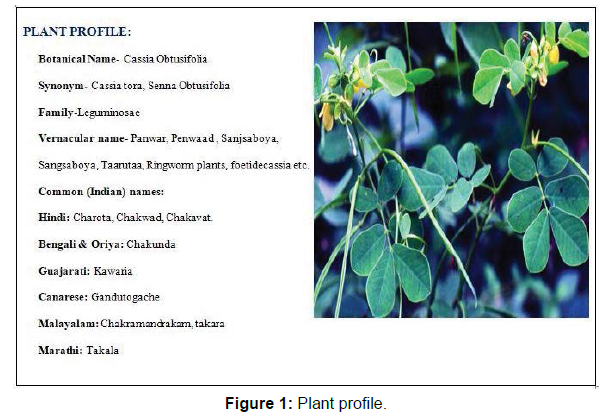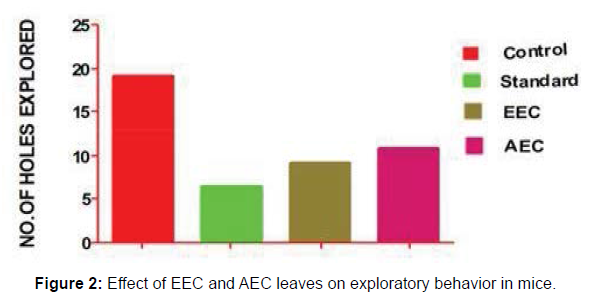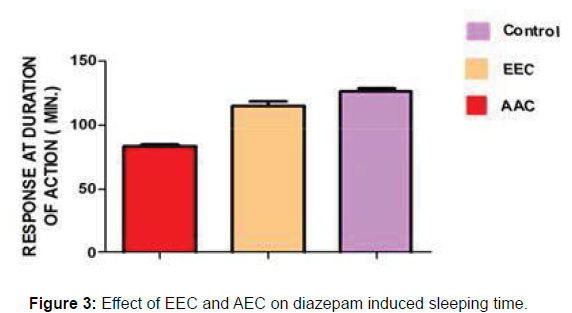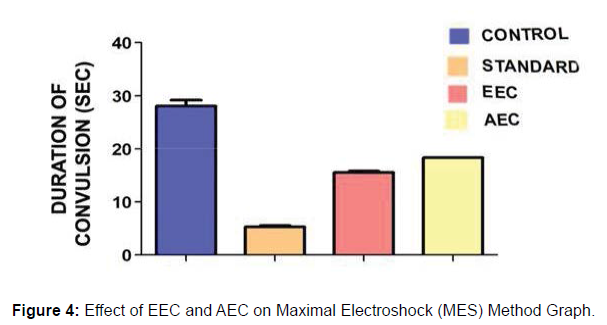A Review - Study on Phytochemical and Neuropharmacological Effects of Cassia Tora Flowers
Received: 01-Nov-2021 / Accepted Date: 22-Nov-2021 / Published Date: 29-Nov-2021
Abstract
Cassia tora flowers family-Leguminosae/Fabaceae has great medicinal properties and used to treat various diseases. Flowers racemes terminal, oblong to rounded corymbose sepals 5. petals 5, yellow, perfect stamens 6-7. Contains chemical compounds like: Anthraquinoness, chrysophanol, emodine, rhein, euphol, basseol, iso-istearic, palmatic, behenic acid etc., all chemicals isolated from this plants drugs that affects the nervous system and its functioning, within the brain. There are still no effective therapies Neurological related problems are so common today, that approximately 18% population suffer from disorders each year. These disorders produce serious health problems like behavioral/cognitive syndrome, sleep disorders, peripheral disorders, epilepsy, neurodegenerative disorders, Parkinsonism, neoplasm and many others. Parts of Cassia tora are used as an antifungal, antihelmintic, diuretic, expectorant, and laxative, treatment of glaucoma, hypertension, and treatment of skin diseases, ringworm and itch. Pharmacological and phytochemical studies of flowers part of Cassia tora plants which have been done in different parts.
Keywords
Phytochemical and neuropharmacological effects; Cassia tora
Introduction
Medicinal herbs constitute the corner stone of traditional medicinal practice worldwide. These herbs are relatively cheap and easily available. These medicinal plants represent a great deal of untapped reservoir of drugs and the structural diversity of their component molecule makes a valuable source of novel lead compounds. The world health organization about 80% of living organism like: Human, developing countries almost exclusively on traditional medicines for first health care needs [1-3]. The present review traditional medicines uses and recent studies on the active isolated compounds. The hole plants as well as specific parts like: Roots, Leaves, Seeds and Flowers have been widely used in Indian and south Asian medicine it is an annual monsoon weed prevalent in wastelands having many antimicrobial properties, have the problem of pollution and health hazards of conventional agro chemical in view deals with conducted to test its seeds extract against the common aerial fungus, soil fungus and root fungus in forest eco-systems [4]. Furthermore, about 80% of the world population is dependent on plantbased drugs (WHO, 1996). In Nigeria and most developing countries of the world, rural and urban dwellers, literate or illiterate rely heavily on herbal preparations for the treatment of various diseases despite the availability of orthodox medicine the alternate system of medicine like Ayurveda, Sidda, Unnani, and other tribal folklore medicines have significantly contributed to the health care of population of India [5,6]. Today, these systems are not only complementary but also competitive in the treatment of various diseases. Initially the materials employed in these traditional medicines were almost botanical origin [7].
Materials and Methods
The flowers of Cassia tora are collected and shade dried (Table 1 and Figure 1). Coarse powder is made from these dried flowers and subjected to extraction in increasing polarities. Various extracts are prepared by using suitable solvents like petroleum ether, chloroform, alcohol and aqueous solvent. Each crude extract obtained after evaporating the solvent subjected to preliminary phytochemical screening and these extracts are utilized for neuropharmacological activity [8-10]. Stock solution of formulation under study was prepared freshly, on the day of experimentation using distilled water. The dose of formulation-500 mg/kg, was selected for the study, the selected doses represent 1/4 of 2000 mg/kg. Healthy, Albino Swiss mice- the chosen experimental animals were maintained in our animal house (12:12 dark: light cycle), with adequate ventilation, hygienic conditions maintained on normal palliated diet and water ad libitum [11,14]. A group of six animals were housed in polypropylene cage of 26 × 19 × 13cm on paddy husk bed and covered with stainless steel wire mesh 28 × 20.5 cm with provision for water and feed. Healthy, Albino Swiss mice, of either sex (unless otherwise specified) weighing between 18-25 gm. were employed for study [15]. All experiments were performed in research lab all parameters of different tests were observed and recorded by person blind to treatment protocol. For all experiments, group refers to group of six animals (n=6) [16]. Data generated from various experimental procedures were analyzed for statistical significance followed by Dennett’s multiple comparison tests [17].
| Drug | Reagents | Instruments |
|---|---|---|
| Ibuprofen Pentazocine Chlorpromazine Valproic acid Diazepam |
Benedict's reagent Barfoed's reagent Million's reagent Dragendroff's reagent Hager’s reagent Mayer's reagent Wagner's reagent |
|
| Plant: The fresh leaves of Cassia tora |
Chemicals: Petroleum ether Chloroform Ethanol |
-- |
Table 1: Plant materials.
Successive solvent extraction
The powdered material was subjected to batch extraction in Soxhlet apparatus. The solvents used were petroleum ether, chloroform, alcohol and. distilled water. The powdered material of Cassia tora leaves were evenly packed in a Soxhlet extractor for extraction for about 36 hours with different solvents [18].
Preliminary photochemical investigation of extract
Qualitative chemical tests were conducted for Petroleum ether, ethanolic, Chloroform and aqueous extracts of flowers of Cassia tora to identify the various phytoconstituents. The phytochemical investigation showed presence of flavonoids, saponins, carbohydrates, starch, gum, proteins, tannin and phenolic compounds [19,20].
Tests for Carbohydrates- Molisch's test (General test)
For Reducing Sugars- Fehling's test, Benedict's test
Test for Monosaccharide’s- Barfoed's test
Tests for Non-Reducing Sugars- Test solution do not give response to Fehling's and Benedict's test.2. Tannic acid test for starch: With 20% tannic acid, test solution was observed for precipitate [21]
Tests for Proteins- Biuret test, Millon's test, Xanthoprotein test, Test for protein containing sulphur, Precipitation test
Tests for Steroids- Salkowski Reaction, Liebermann-Burchard Reaction
Tests for Amino Acids- Ninhydrin test, Test for Tyrosine, Test for tryptophan
Tests for Flavonoids- Shinoda test, Ferric chloride test
Tests for Alkaloids- Dragendroff's test, Mayer's test, Hager's test, Wagner's test
Tests for Tannins and Phenolic Compounds- To 2-3 ml test solution, added few drops of following solutions and was looked for respective colouration or precipitate
• 5% Ferric chloride solution- Deep blue-black coloured
• Lead acetate solution- White precipitate
• Gelatin solution- White precipitate
• Bromine water- Decoloration of bromine water
• Acetic acid solution- Red colour solution
• Potassium dichromate- Red precipitate
Tests for Vitamins- Test for Vitamin A, Test for vitamin C (Ascorbic acid), Test for Vitamin D
Tests for glycosides
General test for Glycosides: Part A- To 2-3 ml of extract dil H2SO4was added and heated on a water bath for 1-2mins. Neutralise with 10% NaOH, check with litmus paper and to resulting solution add Fehling's A and B. Increased red precipitate in this case shows glycosides are present. Part B- To 2-3 ml of extract, water was added and heated. According to need, NaOH was added for neutrlaisation and also added equal quantity of water [22]. To the resulting solution added Fehling's A and. Increased red precipitate in this case showed glycosides are absent [23].
Tests for Cardiac Glycosides: Baljet's test, Legal's test (For cardenoloids), Test for deoxysugars (Kellar Killani test), Libermann's test (For bufadenolids) [24].
Tests for Saponin Glycosides: Foam test, Haemolytic test Pharmacological investigation
Acute (oral) toxicity study (Acute oral toxicity Fixed Dose Procedure, FDP): Acute oral toxicity study for the proprietary formulation was carried out using OECD/OCED guideline 420 (modified adopted 23rd march 2006). The test procedure minimizes the number of animals required to estimate the oral acute toxicity of a chemical and in addition estimation of LD50, confidence intervals [25,26]. The test also allows the observation of signs of toxicity and can also be used to identify chemicals that are likely to have low toxicity.
Principle of the FDP: The fixed dose procedure is method for assessing acute oral toxicity that involve the identification of a dose level that cause evidence of non-lethal toxicity(termed evident toxicity) rather than a dose level that cause lethality [27]. Evident toxicity is a term describing clear signs of toxicity following administration of test substance, such that an increase to the next highest fixed dose would result in the development of severs toxic signs and probably mortality.
Procedure: Healthy, young adult Albino Swiss mice (18-25 gm), nulliporous and non-pregnant were used for this study Food, but not water was withheld for 3-4 hours and further 1-2 hours post administration of sample under study Fixed dose level of 5, 50, 500 mg/kg were initially chosen as dose level that would be expected to allow the identification of dose producing evident toxicity. During the validation procedure, a fixed dose of 2000mg/kg was added to provide more information on substance of low acute toxicity [28].
Observation: Animals were observed individually at least every 5 minutes once during first 30 minutes after dosing, periodically at 2hrs during the first 24 hrs (with special attention during the first four hours) and daily thereafter, for a total of 14 days [29].
Result
Percentage Yield, Colour, Consistency and Solubility in Water of Different Extracts (Table 2).
| Plant Part Used | Extracts | Percentage Yield | Color | Consistency | Solubility in Water |
|---|---|---|---|---|---|
| Cassia tora leaves |
Petroleum | 2.08 | Dark green | Sticky | Insoluble |
| Chloroform | 1.95 | Dark green | Sticky | Soluble | |
| Ethanol | 1.96 | Dark green | Sticky | Highly soluble | |
| Aqueous | 2.13 | Dark brown | Dry powder | Highly soluble |
Table 2: Percentage yield, colour, consistency and solubility in water of different extracts.
Preliminary phytochemical screening of Cassia tora (Table 3)
| Phytocheical constituents | Pet ether | Chloroform | Ethanol | Aqueous |
|---|---|---|---|---|
| Alkaloids | - | + | + | + |
| Glycosides | - | ++ | ++ | ++ |
| Carbohydrates | - | + | + | + |
| Flavonoids | - | + | +++ | +++ |
| Saponins | - | + | +++ | +++ |
| Tannins | - | + | +++ | +++ |
| Steroids | - | - | ++ | ++ |
| Proteins | + | + | + | + |
| Fats and oils | ++ | - | - | - |
| Starch | - | - | ++ | ++ |
| Gums | - | - | +++ | +++ |
| Phenolic compounds | - | - | +++ | +++ |
| - absent ++more clarity + indicates +++ better response |
||||
Table 3: preliminary phytochemical screening of Cassia tora.
Neuropharmacological study (Tables 4-6 and Figures 2-4)
| S.no | Groups | Dose(mg/kg) | No.of Head dip |
|---|---|---|---|
| 1 | Control | - | 19.2±1.12 |
| 2 | Chlorpromazine | 1 | 6.33±0.66 c |
| 3 | EEC | 500 | 9.17±7.45a,d |
| 4 | AEC | 500 | 10.83±1.95a,d |
| All values are mean±SEM, (n=6), aP<0.05, cP<0.001, when compared with control. dP<0.05 when compared with standard. | |||
Table 4: Effect of EEC and AEC on Exploratory behavior in mice.
| Sr. No. | Groups | Dose (mg/kg) | No, of head dip | Percentage Inhibition |
|---|---|---|---|---|
| 1 | Control | - | 19.2±1.12 | - |
| 2 | Standard (Chlorpromazine) | 1 | 6.33±0.66c | 67.03.52 |
| 3 | Ethanolic extract | 500 | 9.17±7.45a,d | 52.23 |
| 4 | Aqueous extract | 500 | 10.83±1.95a,d | 43.59 |
Table 5: Effect of EEC and AEC flowers on exploratory behavior in mice (Percentage inhibition).
| Sr. No. | Groups | Dose (mg/kg) | Onset of Action (min) | Duration of Action (min) |
|---|---|---|---|---|
| 1 | Control(Diazepam) | 5 | 121.8 ± 5.5 | 83.00 ± 2.04 |
| 2 | EEC+Diazepam | 500 | 83.83 ± 2.15b | 114.7 ± 3.48b |
| 3 | AEC+Diazepam | 500 | 54.00 ± 1.65b | 126.0 ± 1.92b |
| All values are mean±SEM, n=6, bP<0.001, when compared with control | ||||
Table 6: Effect of EEC and AEC on diazepam induced sleeping time.
Conclusion
The present work suggests that it requires isolating and characterizing the active components responsible for the neuropharmacological activities and further studies to reveal the exact mechanisms of action responsible for the neuropharmacological activities of Cassia tora flowers. Both the extracts EEC and AEC at the dose 500 mg/kg body weight along with valproic acid at the dose 300 mg/kg body weight showed significant reduction in time to recover from electrically induced convulsions in mice when compared with control group (15.52 ± 0.22, 18.33 ± 0.16 and 28.17 ± 1.01, P<0.001, P<0.001 and P<0.001). The sedative-hypnotic effect of EEC and AEC was assessed using diazepam induced sleeping time. The preliminary phytochemical evaluation of different extracts of cassia tora flowers revealed the presence of flavonoids, carbohydrates, starch, gum, proteins, tannins, saponins and phenolic compounds. The results of phytochemical analysis were significant in ethanolic and aqueous extracts when compared with petroleum ether and chloroform extracts. In the present study effect of EEC and AEC on various parameters like exploratory behavior, analgesic activity, sleeping time and anti-convulsion activity was studied to expose the neuropharmacological property in different animal models.
References
- Dabriyal RM, Narayana DBA (1998) Ayurvedic Herbal Raw Material, The Eastern Pharmacist, pp:31-35.
- Nadkarni KM, Nadkarni AK (1954) Indian Materia Medica, Vol I. Popular Book Depot, Mumbai, p:291.
- Green MM, Singer JM, Sutherland DJ, Hibben CR (1991) Larvicidal activity of Tagtes minuta (marigold) toward Aedes aegypti. J Am Mosq Control Assoc 7:282-286.
- Jang YS, Baek BR, Yang YC, Kim MK, Lee HS (2002) Larvicidal activity of leguminous seeds and grains against Aedesa egypti and Culex pipiens pallens. J Am Mosq Control Assoc 18:210-213.
- Zadikoff CM (1979) Toxic encephalopathy associated with use of insect repellent. J Paediatr 95:140-142.
- Yen GC, Chung DY (1999) Antioxidant effects of extracts from Cassia tora L. Prepared under different degrees of roasting on the oxidative damage to biomolecules. J Agric Food Chem 47:1326-1332.
- Wink M (1993) Production and application of phytochemicals from an agricultural perspective. In: van Beek TA, Breteler H, eds. Phytochemistry and agriculture Oxford, United Kingdom: Clarendon Press, Pp:171-213.
- Choi JS, Lee HJ, Park KY, Ha JO, Kang SS (1997) In Vitro antimutagenic effects of anthraquinone aglycones and naphthopyrone glycosides from Cassia tora. Planta Med 63:11-14.
- Jain S, Patil K (2010) Phytochemical and pharmacological profile of Cassia tora Linn-an overview. Indian J Nat Pro Res 1:430-437.
- Froestl W, Pfeifer A, Muhs A (2013) Cognitive enhancers (Nootropic) Part 3: Drug interacting with targets other than receptor or enzymes, disease modifying drugs. J Alz Dis 34:1-114.
- Pitchaimani V, Arumugam S, Thandavarayan RA, Thiyagarajan MK, Aiyalu R, et al. (2012) Nootropic activity of acetaminophen against Colchicine induced cognitive impairment in rats. J Clin Biochem Nutr 50:241-244.
- Ingkaninan K, Temkitthawon P, Chuenchom K, Yuyaem T, Thongnoi W (2003) Screening for acetylcholinesterase inhibitory activity in plants used in Thai traditional rejuvenating and neurotonic remedies. J Ethnopharmacol 89:261-264.
- Murray A, Faraoni M, Castro M, Alza NP, Cavallaro V (2013) Natural AChE inhibitors from plants and their contribution to Alzheimer’s disease therapy. Cur Neuropharmacol 11:388-413.
- Akbar S, Tariq M, Nisa M (1984) A Study on CNS depressant activity of Salviahaematodes Wall. Pharmaceu Biol 22:41-44.
- Varma RK, Garg BD, Ahmad A (1986) Pharmacodynamic studies on Kalanchoe integra-an indigenous plant 18:78-83.
- Syed Kamil M, Ahmed LT, Paramjyothi S (2010) Neuropharmacological effects of ethanolic extract of Portulaca quadrifida Linn. In mice. International Journal of PharmTech research 2:1386-1390.
- Trease GE, Evans MC (2002) Textbook of Pharmacognosy, 14th edn. London, Pp:81-90.
- Sonavane G, Sarveiya V, Kasture V, Kasture SB (2001) Behavioral actions of Myristica fragrans seeds. Indian J Pharmacol 33:417-424.
- Radhakrishnan R, Zakaria MNM, Islam MW, Chem HB, Kamil M, et al. (2001) Neuropharmacological actions of Portulaca oleraceae LV Sativa (Hawk). J Ethanopharm 200;76:171-176.
- Shafiuddin MD, Liyakhat Ahmed MD, Taranalli AD, Khaja P (2009) Influence of cyclohexanoyl thiosemicarbazide and some anticonvulsant drugs on neurotransmitter levels in rat-brain. Int J Chem Sci 7:264-272.
- Sonavane G, Sarveiya V, Kasture V, Kasture SB (2001) Behavioral actions of Myristica fragrans seeds. Indian J Pharmacol 33:417-424.
- Sandabe UK, Onyeyili PA, Chibuz GA (2003) Sedative and anticonvulsant effects of aqueous extract of Ficus sycomorus L. (Moraceae) stembark in rats. Veterinarski Arhiv 73:103-110.
- Tripathi KD (1988) Essential Medical pharmacology, 2nd edn. Jaypee Brothers Publication, New Delhi:390-91.
- Rahimi R, Nikfar S, Abdullahi M (2009) Efficacy and tolerability of Hypericumperforatum in major depressive disorder in comparison with selective serotinreuptake inhibitors: A Metaanalysis. Prog Neuropsychopharmacol Biol Psychiatry 33:118-127.
- Kokate CK, Purohit AP, Gokhale SB (2006) Textbook of Pharmacognosy, 36th edn; Nirali Publication, Pune 36:126.
- Everitt BJ, Robbins TW (2005) Neural systems of reinforcement for drug addiction from actions to habits to compulsion. Nat Neurosci 8:1481-1489.
- Hosseinzadeh H, Khosravan V (2002) Anticonvulsant effects of aqueous and ethamolic extracts of Crocus sativus L. stigmas in mice. Arch Irn Med 5:44-47.
Citation: Hussain T, Hafiz A, Kumar VR, Kumar D, Kazmi I (2021) A Review - Study on Phytochemical and Neuropharmacological Effects of Cassia Tora Flowers. Clin Pharmacol Biopharm, 10: 239.
Copyright: © 2021 Hussain T, et al. This is an open-access article distributed under the terms of the Creative Commons Attribution License, which permits unrestricted use, distribution, and reproduction in any medium, provided the original author and source are credited.
Select your language of interest to view the total content in your interested language
Share This Article
Recommended Journals
Open Access Journals
Article Usage
- Total views: 2592
- [From(publication date): 0-2021 - Dec 09, 2025]
- Breakdown by view type
- HTML page views: 1963
- PDF downloads: 629




